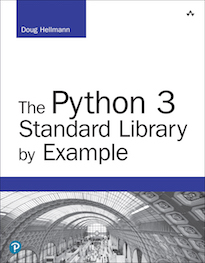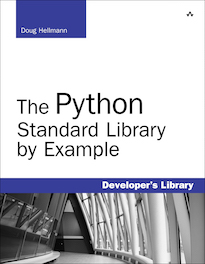time – Functions for manipulating clock time¶
| Purpose: | Functions for manipulating clock time. |
|---|---|
| Available In: | 1.4 or earlier |
The time module exposes C library functions for manipulating dates and times. Since it is tied to the underlying C implementation, some details (such as the start of the epoch and maximum date value supported) are platform-specific. Refer to the library documentation for complete details.
Wall Clock Time¶
One of the core functions of the time module is time(), which returns the number of seconds since the start of the epoch as a floating point value.
import time
print 'The time is:', time.time()
Although the value is always a float, actual precision is platform-dependent.
$ python time_time.py
The time is: 1205079300.54
The float representation is useful when storing or comparing dates, but not as useful for producing human readable representations. For logging or printing time ctime() can be more useful.
import time
print 'The time is :', time.ctime()
later = time.time() + 15
print '15 secs from now :', time.ctime(later)
Here the second output line shows how to use ctime() to format a time value other than the current time.
$ python time_ctime.py
The time is : Sun Mar 9 12:18:02 2008
15 secs from now : Sun Mar 9 12:18:17 2008
Processor Clock Time¶
While time() returns a wall clock time, clock() returns processor clock time. The values returned from clock() should be used for performance testing, benchmarking, etc. since they reflect the actual time used by the program, and can be more precise than the values from time().
import hashlib
import time
# Data to use to calculate md5 checksums
data = open(__file__, 'rt').read()
for i in range(5):
h = hashlib.sha1()
print time.ctime(), ': %0.3f %0.3f' % (time.time(), time.clock())
for i in range(100000):
h.update(data)
cksum = h.digest()
In this example, the formatted ctime() is printed along with the floating point values from time(), and clock() for each iteration through the loop. If you want to run the example on your system, you may have to add more cycles to the inner loop or work with a larger amount of data to actually see a difference.
$ python time_clock.py
Sun Mar 9 12:41:53 2008 : 1205080913.260 0.030
Sun Mar 9 12:41:53 2008 : 1205080913.682 0.440
Sun Mar 9 12:41:54 2008 : 1205080914.103 0.860
Sun Mar 9 12:41:54 2008 : 1205080914.518 1.270
Sun Mar 9 12:41:54 2008 : 1205080914.932 1.680
Typically, the processor clock doesn’t tick if your program isn’t doing anything.
import time
for i in range(6, 1, -1):
print '%s %0.2f %0.2f' % (time.ctime(), time.time(), time.clock())
print 'Sleeping', i
time.sleep(i)
In this example, the loop does very little work by going to sleep after each iteration. The time() value increases even while the app is asleep, but the clock() value does not.
$ python time_clock_sleep.py
Sun Mar 9 12:46:36 2008 1205081196.20 0.02
Sleeping 6
Sun Mar 9 12:46:42 2008 1205081202.20 0.02
Sleeping 5
Sun Mar 9 12:46:47 2008 1205081207.20 0.02
Sleeping 4
Sun Mar 9 12:46:51 2008 1205081211.20 0.02
Sleeping 3
Sun Mar 9 12:46:54 2008 1205081214.21 0.02
Sleeping 2
Calling sleep() yields control from the current thread and asks it to wait for the system to wake it back up. If your program has only one thread, this effectively blocks the app and it does no work.
struct_time¶
Storing times as elapsed seconds is useful in some situations, but there are times when you need to have access to the individual fields of a date (year, month, etc.). The time module defines struct_time for holding date and time values with components broken out so they are easy to access. There are several functions that work with struct_time values instead of floats.
import time
print 'gmtime :', time.gmtime()
print 'localtime:', time.localtime()
print 'mktime :', time.mktime(time.localtime())
print
t = time.localtime()
print 'Day of month:', t.tm_mday
print ' Day of week:', t.tm_wday
print ' Day of year:', t.tm_yday
gmtime() returns the current time in UTC. localtime() returns the current time with the current time zone applied. mktime() takes a struct_time and converts it to the floating point representation.
$ python time_struct.py
gmtime : (2008, 3, 9, 16, 58, 19, 6, 69, 0)
localtime: (2008, 3, 9, 12, 58, 19, 6, 69, 1)
mktime : 1205081899.0
Day of month: 9
Day of week: 6
Day of year: 69
Parsing and Formatting Times¶
The two functions strptime() and strftime() convert between struct_time and string representations of time values. There is a long list of formatting instructions available to support input and output in different styles. The complete list is documented in the library documentation for the time module.
This example converts the current time from a string, to a struct_time instance, and back to a string.
import time
now = time.ctime()
print now
parsed = time.strptime(now)
print parsed
print time.strftime("%a %b %d %H:%M:%S %Y", parsed)
The output string is not exactly like the input, since the day of the month is prefixed with a zero.
$ python time_strptime.py
Sun Mar 9 13:01:19 2008
(2008, 3, 9, 13, 1, 19, 6, 69, -1)
Sun Mar 09 13:01:19 2008
Working with Time Zones¶
The functions for determining the current time depend on having the time zone set, either by your program or by using a default time zone set for the system. Changing the time zone does not change the actual time, just the way it is represented.
To change the time zone, set the environment variable TZ, then call tzset(). Using TZ, you can specify the time zone with a lot of detail, right down to the start and stop times for daylight savings time. It is usually easier to use the time zone name and let the underlying libraries derive the other information, though.
This example program changes the time zone to a few different values and shows how the changes affect other settings in the time module.
import time
import os
def show_zone_info():
print '\tTZ :', os.environ.get('TZ', '(not set)')
print '\ttzname:', time.tzname
print '\tZone : %d (%d)' % (time.timezone, (time.timezone / 3600))
print '\tDST :', time.daylight
print '\tTime :', time.ctime()
print
print 'Default :'
show_zone_info()
for zone in [ 'US/Eastern', 'US/Pacific', 'GMT', 'Europe/Amsterdam' ]:
os.environ['TZ'] = zone
time.tzset()
print zone, ':'
show_zone_info()
My default time zone is US/Eastern, so setting TZ to that has no effect. The other zones used change the tzname, daylight flag, and timezone offset value.
$ python time_timezone.py
Default :
TZ : (not set)
tzname: ('EST', 'EDT')
Zone : 18000 (5)
DST : 1
Time : Sun Mar 9 13:06:53 2008
US/Eastern :
TZ : US/Eastern
tzname: ('EST', 'EDT')
Zone : 18000 (5)
DST : 1
Time : Sun Mar 9 13:06:53 2008
US/Pacific :
TZ : US/Pacific
tzname: ('PST', 'PDT')
Zone : 28800 (8)
DST : 1
Time : Sun Mar 9 10:06:53 2008
GMT :
TZ : GMT
tzname: ('GMT', 'GMT')
Zone : 0 (0)
DST : 0
Time : Sun Mar 9 17:06:53 2008
Europe/Amsterdam :
TZ : Europe/Amsterdam
tzname: ('CET', 'CEST')
Zone : -3600 (-1)
DST : 1
Time : Sun Mar 9 18:06:53 2008

